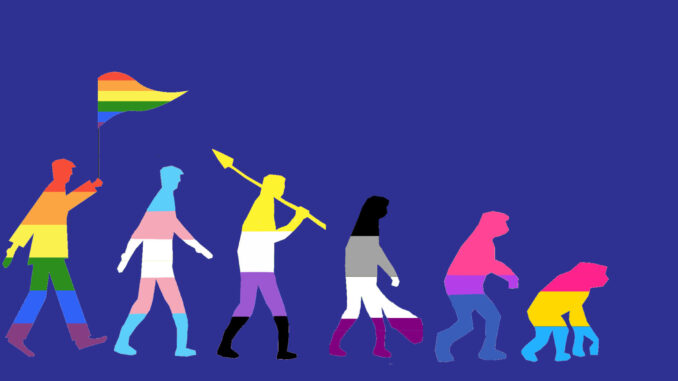
The profusion of Pride standards demonstrates both the triumph of the movement and its disunion.
June brings with it Pride Month, arguably the highest feast of the secular-religious calendar. Go to any major city in America, and you will find government-sponsored welcome signs in airports, subways, busses, trains, and public institutions. This celebration’s most potent visual signifier is the Pride flag, an ever-evolving banner. The Pride flag is presented as an emblem of inclusion, love, and tolerance. However, an analysis of the historical uses of flags in general, and the recent proliferation of LGBT flags in particular, illustrates two truths. The first is that contrary to the claims of those who fly it, the Pride flag is a tool of symbolic exclusion and division. The second truth is that the flag is a signifier of a particular garrison in the culture war and, in a larger sense, a marker of the total institutional capture achieved by the cultural left.
So fearful of the mere appearance of exclusion or intolerance, the flag has become a collage of leftist, globalist, and secular interests, including BIPOC activism and trans-ideology, alongside the ever-broadening spectrum of LGBTQIAA2S+ identities. The crowding of these diverse interests onto the flag might suggest to some that it genuinely is about inclusion and community rather than division. But the incessant invention of new sexual identities via minute parsings of sexual desire (or the lack thereof) indicate the inclination of the LGBT movement to fragment itself, which mirrors its aims for the nation at large. History teaches us that this fragmentation might ultimately lead to the collapse of the LGBT empire—think of the Austro-Hungarian Empire, with its ten major languages and seven major religions.
An image that was recently circulating on Twitter exposes how efforts at “inclusion” are really an unceasing process of division. The image in question assists viewers in understanding the galaxy of identities represented under the “umbrella” of “asexuality.” In the new vocabulary of the cultural left, asexuality means the lack of an appetite for sex. As the image shows, though, asexuality is far too broad a term to unify all people who “identify” as asexual since it erases the very subtle (and apparently, very important) quirks that define individuals’ particular brands of asexuality. They are working out a constellation of sub-sub-sub categories of asexuality: “Cupiosexual,” “Acespike,” “Fraysexual,” Graysexual,” “Proculsexual,” and dozens more. Therefore, in addition to the overarching flag that “unites” the asexuals (and divides them from the larger community represented by the Pride flag), there must be a fleet of other flags to affirm the irreducible differences that necessarily splinter the larger “community.”
It is an interesting question why the LGBT movement even has a flag at all. Almost always, a flag represents a polity, a geopolitical entity that wields political power. Cities might have a flag. Each American state has a flag. Nations have flags. On the other hand, cultures do not. Historically, the functions of a flag are four: to authenticate identity, to make or announce a claim to some territory or property, to mark divisions in battle, and to summon solidarity and allegiance among a group of people the flag purports to represent.
To this end, flags have played an important role in naval conflict. Some flags identify the nation that a ship represents and the visualization of these allegiances plays a role in how battles are initiated. Sometimes, a ship’s crew will decide not to fly a flag—particularly when facing the risk of an attack by a superior foe. The Pride flag is also a means to verify identity. One of the major arguments justifying the need for public displays of LGBT pride is that it fights against an enduring stigma that marginalizes sexual minorities. But as a vulnerable ship conceals its identity, it follows that vulnerable people would conceal their vulnerability. If, in fact, there did exist a widespread stigma attached to being LGTB, one would assume that an LGTB individual would have to conceal their identity. On the contrary, the omnipresence of this flag in America shows that whatever stigma remains is either negligible or is outweighed by the incentives that correspond with such identification. Either way, the prominence of the Pride flag in everyday life suggests that those who fly it operate from a position of power—like a battleship announcing its presence and preparedness for the fight.
When the Americans first landed on the moon, we planted the flag of the United States on the lunar surface. This act conveyed a symbolic ownership of the moon. However, the ownership that flags announce is often literal. In the various “land runs” that the U.S. government sponsored to help colonize the west, settlers raced to be the first to claim available land, a feat that was often achieved by sinking a flag in the ground. Indeed, marking territory was the first use of the Pride flag. On my childhood trips to Toronto in the mid-1980s, rainbow flags flying outside of homes, restaurants, and bars delineated the space of the “gay village,” a city within the city, deliberately marked off as separate from the larger community by the inhabitants of the neighborhood.
More recently, ostensibly “neutral” entities of the state have started to fly these flags, demonstrating their commitment to advancing leftist interests via the power of government. This trend began most prominently when Obama allowed the White House to be bathed in rainbow-themed light on the night of the Obergefell ruling, which legalized gay marriage nationwide. The speed at which this institutional capture occurred was head-spinning: remember that only seven years earlier, candidate Obama had said that he personally believed marriage should be defined as a union between a man and a woman. More recently, U.S. embassies and consulates have flown the Pride flag—often in nations that are simultaneously not hospitable to LGBT policy preferences and powerless to do anything about America’s disregard for their culture. These acts are a potent signifier that this secular ideology of radical sexual autonomy is a driving force of American influence abroad and a deliberate announcement by our government that it intends to export this ideology to other nations. Curiously, though, we don’t fly the Pride flag in the countries where homosexuality is punishable by death.
In premodern warfare, flags and field signs were often used to reposition forces on the battlefield and initiate tactical movements—today, the Pride flag functions similarly. TikTok is full of public schoolteachers explaining that the Pride flag is the most important thing in their classroom because their presence (and the public explanation of the importance of their display) is an announcement to culture warriors on the left to move the fight to the schools. Having already captured the institutions of the state, the LGBT horde’s next target becomes the institutions that serve our children. As such, by staking their flags in classrooms across America, they are signifying another successful phase in their cultural revolution.
When reflecting upon the LGTB community as a whole, it is helpful to recall Benedict Anderson’s remarks that “communities” are largely imagined concepts. By this, he means that the existence of a community requires a shared belief in which certain fictions are treated as truths. Three of these purported fictions are: that there are finite, defined boundaries that mark the community off from other ones; that there is a genuine loyalty and emotional bond connecting the people who inhabit the community; and that the community has an exclusive ability to control its destiny. Anderson asserts that no nation or polity can fully satisfy these criteria, so any perception of community is really the result of something like a mass delusion. To this end, symbols, like flags, play an important role in catalyzing this sense of community among a group of people. The Pride flag is no exception to this rule. It seeks to establish a communal sense of belonging—but does it succeed?
Consider the American flag, which is meant to represent all Americans. There are smaller constituencies within the United States that also have flags, but these flags merely represent regions and the groups within them. For instance, the North Carolina flag symbolizes a group of people inhabiting a particular geographic space. It doesn’t aspire to represent their cultural affinities, lifestyles, or the essence of “who they are.” The subsidiary flags under the Pride banner are different: they don’t represent places or polities; they symbolize feelings and desires that some people set as the core of their identity, around which they imagine communities. North Carolina is a space contained within and governed by the United States, but Orchidsexual identity has no inherent relation to the greater LGBT suite of identities besides its purported status as a sexual minority.
Further, America (unlike individual sexual desire) has a limited scope. There is only so much American land that can be subdivided. Currently it is split up into 50 chunks and we can choose at any time to further split or consolidate it. Regardless, America exists within a clearly delineated space—an “outside” into which the nation does not expand. The LGBT movement, in contrast, has an endless proliferation of subsidiary flags representing newly-discovered, boutique identities that border on the absurd. Why shouldn’t a man’s sexual preference for blondes be defined as the core of his personhood? There is no potential limit to the range of sexual identities that can be crammed under the LGBT umbrella.
Any sexual inclination can be added to the smorgasbord, so long as two conditions are met: a person feels the need to identify that inclination as central to their concept of self, and the proclivity in question deviates in some trivial way from what the imagined LGBT community envisions as “normal,” heterosexual behavior. For this reason, the number of potential subcategories is infinite: every individual can be found to deviate from the sexual norm in some way, however piffling. If people define any of these tiny abnormalities as the essence of their personhood, each of these identities will need its own—no matter how rare they may be. To withhold a flag from them would be to deny the legitimacy of the identity in question, an intolerable act of exclusion and marginalization of the sort LGBT activism explicitly rejects.
Accordingly, if Anderson is correct and communities are “imagined,” none are more dubiously imagined as the LGBT community. The Pride flag is not what it seems. The fact that it exists at all is merely a reminder of the militaristic, territorial, colonizing work of its movement. Rather than signifying a peaceful, affirmative, inclusive celebration, the Pride flag really only serves to delineate the battle lines within the culture war and mark the territory captured by the institutional left. The ranks of the LGBTQIAA2S+ movement continue to swell, strengthening their ability to claim space, but with every new flag and identity added in the name of diversity and inclusion, what it means to be LGBT becomes less clear. If the minoritarian LGBT movement continues expanding its borders and adding new members, it will soon find that it is no longer a “minority” in any meaningful sense. Perhaps that is the goal, but I doubt it. Idiosyncrasy is the highest virtue of the identity cult and cannot be achieved from a majoritarian position.
All-powerful empires must carefully consider their rate of expansion. Eventually, most of them come to claim more territory than they can control. They expand until they occupy the space of so many different peoples with so many competing interests that it becomes impossible to imagine any real community among the diverse groups that inhabit the empire. When this happens, empires fall. They are never really conquered by an outside force; rather, they collapse within themselves. The totalitarian impulse that aims to subordinate and unite the world under the flag of the empire is ultimately self-defeating. Those who fly the Pride flag are indubitably proud—and with good reason. They have claimed a great swath of territory in short order while facing very little resistance. But at this rate of conquest, the Pride flag might soon be a relic—a symbol of the fate of all imperial hubris.
Apareció primero en Leer en American Mind






Be the first to comment